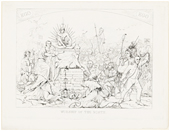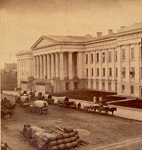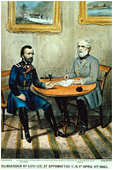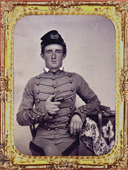
The Death of Ellsworth
April 29, 2011, through March 18, 2012

Col. Elmer E. Ellsworth, the first Union officer to be killed in the Civil War, commanded a volunteer
regiment that participated in the occupation of northern Virginia May 24, 1861. Ellsworth’s death at
the hands of a local innkeeper in Alexandria made headlines throughout the country. He was made a
martyr and served as an inspirational figure for the North throughout the course of the war. Francis E.
Brownell, the soldier who mortally avenged Ellsworth’s assailant, bequeathed several artifacts to the
Smithsonian Institution. Objects on view include Alonzo Chappel’s historic painting Death of
Ellsworth and memorial lithographs that were produced throughout the war in Ellsworth’s memory.
The Confederate Sketches of Adalbert Volck
March 30, 2012, through Jan. 21, 2013

Having come to the United States in 1848 in the wave of immigration from Germany after its failed
revolution, Adalbert J. Volck settled in Baltimore. Unusual for the politically liberal German émigrés,
Volck sided with the Confederacy. Volck, a dentist by trade, served the southern cause in several ways,
including smuggling medical supplies to Virginia across the Potomac. However, Volck’s most significant
contribution to the Confederate cause was his production of pictorial propaganda that vilified President
Abraham Lincoln, northern abolitionists and Union soldiers. While his major publication, Sketches from
the Civil War in North America, had a small circulation, the etchings reveal the Confederate mindset and
contemporary southern opinion.
Mathew Brady’s Photographs of Union Generals
March 30, 2012 through May 2015

Although Mathew Brady may be best known for his photographic documentation of the Civil War, Brady’s New York and Washington galleries also did a brisk business throughout the conflict by producing studio portraits of the ever-changing roster of Union Army generals. Featuring modern albumen prints made from the original Brady negatives in the National Portrait Gallery’s Frederick Hill Meserve Collection, this installation will include portraits of many of the North’s military leaders, from George McClellan and Ambrose Burnside to William Tecumseh Sherman and Ulysses Grant.

Feb. 1, 2013 through March 2, 2014
Drawing principally from images in the National Portrait Gallery’s collection, this exhibition will explore the roles that individual African Americans played during the Civil War and will focus attention on the impact of President Abraham Lincoln’s Emancipation Proclamation. Among the featured stories will be those of Frederick Douglass, Martin Delaney, Sojourner Truth and Gordon, who escaped from enslavement on a Louisiana plantation to join a black regiment and fight for the Union. NPG curator: curator of photographs Ann Shumard.
Washington During the Civil War
Dec. 13, 2013, through Jan. 25, 2015

This exhibition will include approximately forty photographic reproductions showing Civil War activities around the Patent Office Building, now home to the National Portrait Gallery, as well as other recognizable locations in and around the District of Columbia. A display of the forts which surrounded and protected the District, as well as large scale views and maps of the city will also be shown.

March 14, 2014 through April 19, 2015
The Civil War rivalry between generals Ulysses S. Grant and Robert E. Lee is one of the most memorable in American military history. Lee was a polished and seemingly invincible Confederate commander until he encountered Grant, a rough-hewn upstart, in the Virginia campaigns of 1864 and 1865. Ultimately, the Union would prevail, in part through the adoption of a total war philosophy of destroying armies and resources. This exhibition will consider the personal lives and professional rivalries of Grant and Lee through paintings, photographs, documents, and associative objects.
Alexander Gardner
Oct. 31, 2014, through May 3, 2015

Feb. 5, 2015, marks the 150th anniversary of Alexander Gardner’s “cracked-plate” portrait of
President Abraham Lincoln. Arguably the most iconic likeness of the 16th president today, it was
created by a man whose life and photographic career remain relatively undocumented and
underappreciated. This oversight is notable, as Gardner (1821–1882) was perhaps the most progressive
photographer of the Civil War era. He was influential not only in advancing photographic portraiture
beyond traditional compositional conventions, but also in realizing photography’s power as a
documentary tool. In his mind, photographs were more than static likenesses but were active images
capable of conveying narrative and recording history. The author of the first American photographic
book, a leading contributor of photographic views to the illustrated press and a dedicated abolitionist,
Gardner was a pioneer in his field.
American Origins, 1600-1900
Ongoing

A “conversation about America” is on view in a series of 17 galleries and alcoves chronologically
arranged to take the visitor from the days of contact between Native Americans and European
explorers through the struggles of independence to the Gilded Age. Major figures from Pocahontas to
Chief Joseph, Alexander Hamilton to Henry Clay, and Nathaniel Hawthorne to Harriet Beecher Stowe
are among those included.
Three of the galleries are devoted exclusively to the Civil War, examining this conflict in depth. A
group of modern photographic prints produced from Mathew Brady’s original negatives complements
the exhibition. Highlights from the Gallery’s remarkable collection of daguerreotypes, the earliest
practical form of photography, are on view in “American Origins,” making the National Portrait
Gallery the first major museum to create a permanent exhibition space for daguerreotype portraits.
![]()